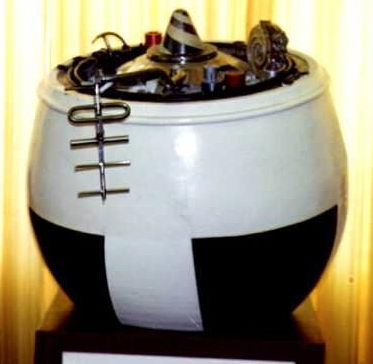
V-71 type Venus entry capsule
Continued from JSR 762 ( https://planet4589.org/space/jsr/back/news.762.txt )
In the late 1960s and early 1970s the newly-formed IKI (Space Research Institute) and the Lavochkin company developed a series of Venus probes based on an evolution of Korolev's early Mars/Venera probe design. In the 1972 Venus window, the last two such probes were launched: V-71 No. 670 and V-71 No. 671, both on Molniya-M (8K78M) four-stage launch vehicles (basically Soyuz rockets with a fourth stage, in this case the Blok-NVL)
Probe No. 670 was boosted to solar orbit and named Venera-8 ("Venus-8"). It was launched on 1972 Mar 27 and successfully landed on Venus on 1972 Jul 22, surviving for 50 minutes on the surface.
Probe No. 671, launched on 1972 Mar 31, didn't go so well. The lower 3 stages of the Molniya-M rocket put the stack in a 196 x 215 km Earth parking orbit. Then the Blok-NVL's BOZ ullage motor unit fired to give the upper stage a little kick and itself separated. The Blok-NVL main engine now ignited but shut down prematurely, 2 min into a 4 min burn. The Venera probe/Blok-NVL stack was now stranded in a 206 x 9800 km Earth orbit.
The USSR had been planning to name the probe 'Venera-9', but after the failure they pivoted to announcing it as 'Kosmos-482', just another nondescript government satellite, nothing to see here, move along...
The Kosmos name is used as a generic cover name for all sorts of military and civilian programs, and to hide failures.
US tracking found THREE objects in this orbit. One was labelled as Kosmos-482, one as the rocket stage, and one as debris. "Kosmos-482" and the "rocket stage" (1972-023A and B) had relatively rapid orbital decay and reentered in 1981 and 1983 respectively. The debris object, 1972-023E, came down more slowly.
In Sep 2000 I noted this and discussed with a few experts the possiblity that, with its 1 sq m radar cross section, 23E (object 6073) might be the separated Venera descent sphere; I started labelling it as such in my online satellite catalog. Funnily enough, in June 2002 the NORAD satellite catalog starting labelling 6073 as the Venera descent sphere too. Probably just a coincidence.
The low perigee of 6073 led to a brief flurry of media interest in 2019 when someone mistakenly imagined that meant it would reenter soon, despite its high apogee. I pointed out this was wrong and said "Reentry probably early-mid 2020s?". But here we are six years later and it is finally time for the object to reenter - Marco Langbroek estimates this will happen between May 7 and 13.
I am moderately confident that object 6073 is the Kosmos-482 entry capsule. If it is, its heat shield means that the half-ton, one-metre-diameter sphere might well survive Earth atmosphere entry and hit the ground. In which case I expect it'll have the usual one-in-several-thousand chance of hitting someone. The vehicle is dense but inert and has no nuclear materials. No need for major concern, but you wouldn't want it bashing you on the head.
As of May 7, the expected reentry time is sometime from May 9 to May 11.
Kosmos-482 objects, apogee height vs time Black: 23A (service module?); Red; 23D (upper stage); Blue: 23E (Venus entry capsule?)
Kosmos-482 objects, perigee height vs time. Black: 23A (service module?); Red; 23D (upper stage); Blue: 23E (Venus entry capsule?)